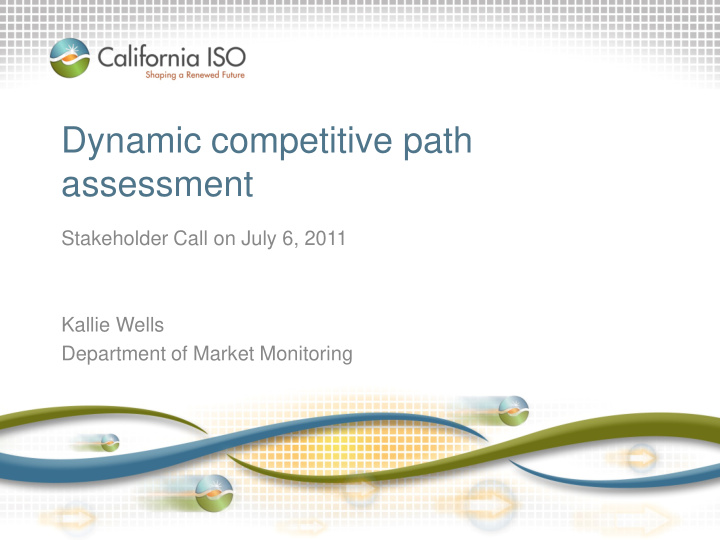



Dynamic competitive path assessment Stakeholder Call on July 6, 2011 Kallie Wells Department of Market Monitoring
Topics covered • Implementation timeline. • Factors considered in pivotal supplier test. • Application in the day ahead market • Application in the hour ahead scheduling process • Application for the 5-minute real time dispatch Page 2
Implementation timeline • Implementation – April 2012: New LMPM in day ahead and HASP – May 2012: Dynamic CPA in day ahead – Q4 2012: New LMPM in RTPD and dynamic CPA in HASP and RTPD • Timing is limited in RTPD • Anticipate needing additional development and testing to apply CPA, LMPM, and bid change every 15-minutes. • Additional changes to settlement to accommodate intra- hour bid changes. Page 3
Factors considered in pivotal supplier test • Consider only net suppliers as potentially pivotal. • Supply portfolios adjusted for tolling agreements. • Consider resources with bids in market and can be started to respond in binding dispatch period. • Will only test binding constraints. • All supply adjusted to account for effectiveness on constraint being tested. • Account for ramping limitations in real time market. • Count cleared virtual supply in demand for counterflow and residual supply of counterflow. Page 4
Application in the day ahead market • Dynamic CPA and LMPM will be run after all constraints run. • Demand for counterflow – Sum of effective dispatch from physical and virtual supply. • Supply of fringe competitive suppliers – Physical: maximum available capacity (PMax – outages) weighted by SF. – Virtual: cleared virtual supply weighted by SF. • Supply of potentially pivotal suppliers – Physical: zero – Virtual: cleared virtual supply weighted by SF. • Top three potentially pivotal suppliers identified by maximum effective available capacity. • Mitigation: Mitigate resource in hour failed test Page 5
Application in the hour ahead scheduling process Same as in day ahead with following differences • No virtual bids. • Supply of fringe competitive suppliers – Physical: maximum output resource could ramp to in 15- minute interval from last dispatch. • Supply of potentially pivotal suppliers – Physical: lowest output resource could ramp to in 15- minute interval from last dispatch. • Top three potentially pivotal suppliers identified by maximum ramp range = maximum capacity that could be withheld. • Mitigation: Mitigate if failed test in any of four 15-minute HASP intervals. Mitigation is hourly for HASP up to RTD. Page 6
Application for the real time dispatch market Same as in HASP with following differences • Uses output from last available RTPD run (not from an all constraints run). • Mitigation: Mitigate if failed test in applicable 15-minute interval of RTPD run. Mitigation is balance of hour – Mitigation begins first RTD interval corresponding to the RTPD interval where resource first failed test. – Bid mitigated from that point to end of hour. Page 7
Questions / Comments ??? Page 8
Recommend
More recommend